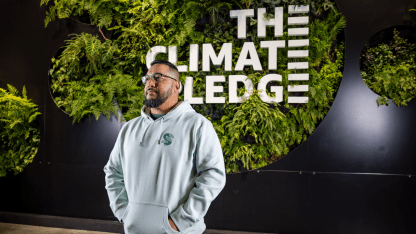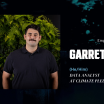Each hockey season, one Pacific Northwest artist is selected to design a merchandise collection that’s net proceeds benefit **One Roof Foundation’s** Environmental Justice Pillar—helping to ensure all youth have clean air to breathe, clean water to drink, and clean and safe places to gather and play. “This is our fourth year of our local artist program at Climate Pledge Arena,“ says Quinn Ianniciello, Creative Director for The Climate Pledge. “We’re thrilled with how this initiative provides regional artists the opportunity to express their artwork through the lens of the climate crisis. It’s yielded some powerful—and beautiful—product designs."
For the Kraken’s debut 2021-2022 season, that artist was Seattle-based illustrator **Erin Wallace**. In 2022-23, it was Seattle-based artist **Jen Ament**, known for her thought-provoking linocut prints and **murals** around town. Last season, it was muralist and illustrator Sarah Robbins whose work creates evocative, naturalist worlds.
This season, it’s Toka Valu, a Tonga-born, Seattle-based artist and illustrator and former college rugby player at the University of Washington. He’d spent more than a decade as a staffer with the university’s Office of Minority Affairs and Diversity before deciding five years ago to move full-time into the ink and cloth design artwork he’d been creating, inspired by his Pacific Islander upbringing.
We sat down with Valu to hear more about his background and the inspiration behind his “Our Eco Kin” collection designs.
Tell us a little bit about your background as an artist.
I’ve been an artist all my life. I was born and raised in the Kingdom of Tonga and came here in 1997. The art I had focused on was just ink and paper. So, that’s really what I’ve been focused on and a lot of it is cultural. And in the past six or seven years, I’ve been really focused on trying to make it – make a run at what it might look like as a career.
So, in 2019 I left the University of Washington. I’d worked there for 10 years, never putting down the art. But then I took a really serious run at this in 2019 right before the pandemic and it’s worked out pretty well ever since. Just a few gigs here and there and then of course the big one with you folks and the Climate Pledge Arena. It’s been an amazing dream so far.
Why is this type of art meaningful to you?
It was what I grew up around when I was a kid. Very much bold, black lines. Very much influenced by both the bark cloth from the Kingdom of Tonga – a lot of bold, black lines there – but also comic books. I was an avid comic book reader growing up and a lot of my figures look comic book inspired.
So, largely based on both the cultural surroundings I came up with and of course the comic books that I so much enjoyed. Coming out here in ’97 when I was 14, a lot of my experience here has also been a significant part of just how I draw and what I think about when I do these things. It’s meaningful in the sense of an expression of who I am culturally. But especially also just who I am as a cultural man here in the Northwest.
There’s not many of us Pacific folks here in this industry. Most of us are in athletics. So, this is my part in helping inspire a different route for some of the young people other than just athletics itself.
You said others like you were in athletics. What sports did you play?
I was in rugby. Tonga is a rugby country, like Samoa or New Zealand. So, that was the sport I was in. When I came out here, it was football. I was super confused by football and didn’t understand it. I tried it out and it didn’t get me anywhere. But I continued to pursue my education at the University of Washington in 2003 when I obtained my permanent residency card and played rugby there for a bit. It’s been an interesting ride.
What inspired your designs for this project?
That’s a great question. So, I thought of the environment as our “kin” right? Like family. When you think of family, you treat them a little differently and are a bit more attentive to their needs.
The personification I came up with was one of earth, of ocean and then of climate. So, for climate, I did an old, elderly man. Like an old, old grandfather. For the ocean, I did kind of a little brother. A rambunctious, real little brother. So, there’s a lot of energy in that particular piece. And the earth one, I kind of envisioned as a mother. I recently just lost my mother in 2017. I lost my brother in 2022. And my grandfather, who was like a father to me, I lost in 1998. So, the three of them were very much in mind when I was doing these pieces.
Basically, if we treat our environment, our ecosystem, like our kin, we’re going to be more attentive to what it’s trying to tell us as far as taking care of the climate, taking care of the ocean and taking care of the land. So, that’s what was really at the heart of it.





















